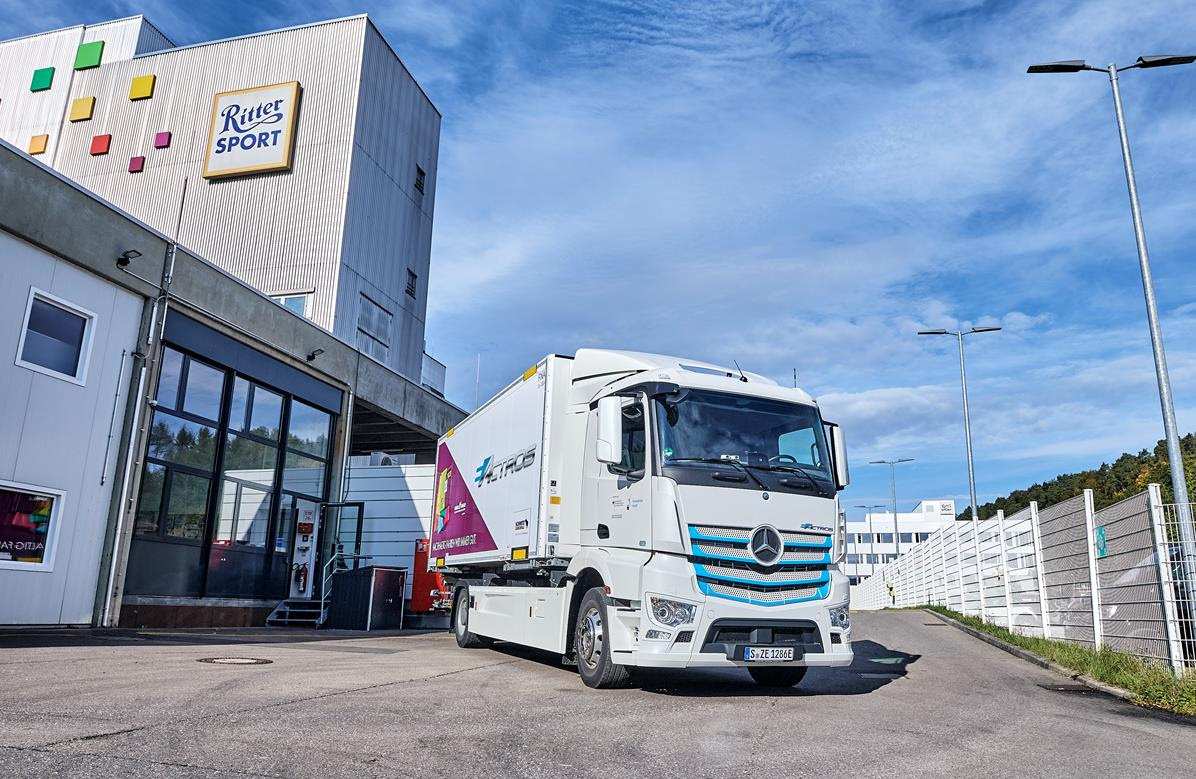Electric. Practical. Good. – Ritter Sport uses all−electric Mercedes−Benz eActros for production supply

- Chocolate manufacturer Alfred Ritter GmbH & Co KG starts practical test with Mercedes-Benz eActros.
- Ritter Sport uses battery-powered 18-ton truck to shuttle between warehouse and factory.
- Cool swap body with electric cooling unit from Schmitz Cargobull enables emission-free temperature-controlled transport.
Stuttgart / Waldenbuch – The battery-powered Mercedes-Benz eActros truck is now in use for the chocolate manufacturer Alfred Ritter GmbH & Co KG. The family-owned company, which specializes in square chocolate bars and is based in Waldenbuch near Stuttgart, is testing the eActros for production supply on the route between the Dettenhausen warehouse and the production site in Waldenbuch. Ritter Sport is using the eActros in flexible shuttle operation to ensure that hazelnuts, almonds, wrapping foil and other packaging materials from the warehouse in Dettenhausen, which is about seven kilometers away, are delivered for the production of chocolate products. The eActros also supplies the “SchokoShop” – Ritter Sport’s factory outlet at the company’s headquarters in Waldenbuch – with freshly produced chocolate from the factory next door. The 18-ton truck with a range of about 200 kilometers is equipped with a Schmitz Cargobull refrigerated swap body, which is also electrically operated and therefore emission free. The batteries of the electric truck are charged overnight on the Ritter Sport factory premises after the day’s tours.
Jasper Hafkamp, Head of Global Marketing Mercedes-Benz Trucks: “For more than two years now, numerous customers have been intensively testing our battery-electric eActros for heavy-duty distribution transport in various areas of application. We are delighted that Ritter Sport – the manufacturer of the well-known square chocolate bars with a long tradition – is now also using the eActros here in the Stuttgart area to supply its production in line with demand.”
Andreas Ronken, CEO at Ritter Sport: “As a family business, the protection of natural resources is an integral element of our corporate activities. Our goal is to operate in harmony with humankind and nature. As part of the supply chain, this naturally includes transport logistics. With the Mercedes-Benz eActros, we are now testing a CO2-neutral transport solution that meets our corporate values of sustainability and transparency.”
Cool swap body with electric cooling unit from Schmitz Cargobull
The cool swap body of the eActros used by Alfred Ritter is the W.KO COOL model from Schmitz Cargobull. It has optimized insulation for the energy-efficient transport of refrigerated goods. Its robust construction is ideal for intensive daily use. The purely electrically powered refrigeration unit operates completely emission-free and is specially designed for use in distribution transport. The vehicle bodies will be largely provided by Schmitz Cargobull also in the second test phase.
Boris Billich, Sales Director at Schmitz Cargobull: “In line with our core brand values of ‘reliable and innovative,’ as a leading manufacturer of truck bodies, we are constantly working on the implementation of environmentally friendly and future-proof transport concepts. With concepts such as the emission-free refrigerated swap body that is installed on the eActros at Ritter Sport, we contribute to CO2 reductions and offer a sustainable system for optimized ecological transport and logistics solutions.”
Numerous insights gained from the first phase
Since 2020, the eActros has been in the second phase of its practical testing and will gradually be handed over to other customers as part of the so-called “innovation fleet.” One of the many findings gained during the practical tests is that the eActros’s range of about 200 kilometers has proven to be absolutely realistic – regardless of payload, route or topography. The eActros is in no way inferior to a conventional diesel truck in terms of availability and performance in urban traffic, on highways or overland routes. The cooling system for the cargo, but also the air conditioning – both electrically operated – have been functioning without any limitation in both extreme heat and winter conditions. Drivers are very pleased with the continuous availability of torque across the entire speed range. They also report in particular on the quiet driving style and a pleasant, smooth driving experience. In addition, when driving with foresight, electrical energy can be recovered through recuperation, i.e. motor braking. It is then rarely necessary to use the brake pedal.
The eActros: locally CO2-neutral alternative for urban distribution traffic
The eActros is based on the chassis of the Mercedes-Benz Actros. In addition, however, the vehicle’s architecture is completely geared to electric drive and has a high proportion of specific parts. Drive is provided by two electric motors close to the rear-axle wheel hubs with an output of 126 kW each and a maximum torque of 485 Nm each. This results in 11,000 Nm each after the transmission ratio, which is a performance equivalent to that of a conventional truck. Lithium-ion batteries with 240 kWh supply the energy for the eActros. Depending on the available charging power, the batteries can be fully charged within two hours (at 150 kW).
The development and testing of heavy-duty electric trucks in distribution transport is being funded partially by the Federal Ministry for the Environment (BMU) and partially by the Federal Ministry of Economics and Energy (BMWi) as part of the Concept ELV² project.
The eActros in series production: outstanding performance
The series-production eActros will be significantly superior to the prototype in a number of respects, such as range, power and safety. The eActros will be launched as a two- and three-axle vehicle. Series production is scheduled to start in 2021 at the Wörth plant on the Rhine. In addition, Daimler Trucks will embed the vehicle in a holistic ecosystem that also includes consulting services relating to e-mobility. They include route analyses, checking for possible subsidies, support for operational fleet integration and the development of suitable charging-infrastructure solutions.




